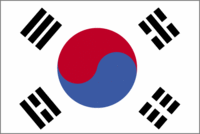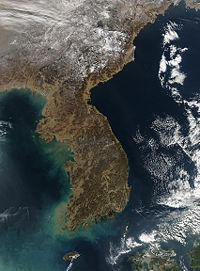South Korea: Difference between revisions
imported>Chunbum Park |
imported>Chunbum Park |
||
| Line 11: | Line 11: | ||
South Korea is largely mountainous, with only 30% of its terrain being the lowlands, concentrated mostly on the western and the southeastern parts of the country.<ref name="encarta">"[http://encarta.msn.com/encyclopedia_761562354/south_korea.html South Korea]," Microsoft Encarta Online Encyclopedia 2008.</ref> Along curve of the eastern coastline, the [[Taebaek Mountains]], the northern end of which originates in North Korea, run in the north-south direction.<ref name="britannica">"[http://school.eb.com/all/eb/article-34954 Korea, South]." ''Encyclopædia Britannica'', date accessed: 2008-11-10.</ref> Four smaller mountain ranges branch off south-westward from the Tabaek Mountains, and, the largest among them, the [[Sobaek Mountains|Sobaek range]], makes a long S-shape that divides the southern region. The highest points of these are the [[Mount Jiri]] on the Sobaek Mountains, reaching a height of 1,915 m (6,283 ft), and [[Mount Sorak]] on the Taebaek range, peaking at 1,708 m (5,604 ft), but none are as high as [[Mount Halla]], which is an extinct volcano with a height of 1,950 m (6,398 ft). It is located on the southern island of Jejudo, which is the country's largest island. | South Korea is largely mountainous, with only 30% of its terrain being the lowlands, concentrated mostly on the western and the southeastern parts of the country.<ref name="encarta">"[http://encarta.msn.com/encyclopedia_761562354/south_korea.html South Korea]," Microsoft Encarta Online Encyclopedia 2008.</ref> Along curve of the eastern coastline, the [[Taebaek Mountains]], the northern end of which originates in North Korea, run in the north-south direction.<ref name="britannica">"[http://school.eb.com/all/eb/article-34954 Korea, South]." ''Encyclopædia Britannica'', date accessed: 2008-11-10.</ref> Four smaller mountain ranges branch off south-westward from the Tabaek Mountains, and, the largest among them, the [[Sobaek Mountains|Sobaek range]], makes a long S-shape that divides the southern region. The highest points of these are the [[Mount Jiri]] on the Sobaek Mountains, reaching a height of 1,915 m (6,283 ft), and [[Mount Sorak]] on the Taebaek range, peaking at 1,708 m (5,604 ft), but none are as high as [[Mount Halla]], which is an extinct volcano with a height of 1,950 m (6,398 ft). It is located on the southern island of Jejudo, which is the country's largest island. | ||
The country's coastline extends 2,413 km (approximately 1,500 mi)<ref name="ciacoast">[https://www.cia.gov/library/publications/the-world-factbook/fields/2060.html "Field Listing - Coastline"], ''The World Factbook'', CIA.</ref>. The southern and western coasts differ greatly from the rockier eastern coast in that they are arranged intricately with harbors and islands, whereas the eastern coastline is smooth and simple.<ref name="encarta"/> Likewise, the tidal ranges vary significantly; on the east side, tides reach only 0.3 m, but the tidal range increases gradually along the south coast and peaks at 910 m (one of the world's highest) in the [[Gyeonggi Bay]] in the northwest. | The country's coastline extends 2,413 km (approximately 1,500 mi)<ref name="ciacoast">[https://www.cia.gov/library/publications/the-world-factbook/fields/2060.html "Field Listing - Coastline"], ''The World Factbook'', CIA.</ref>. The southern and western coasts differ greatly from the rockier eastern coast in that they are arranged intricately with harbors and islands, whereas the eastern coastline is smooth and simple.<ref name="encarta"/> Likewise, the tidal ranges vary significantly; on the east side, tides reach only 0.3 m, but the tidal range increases gradually along the south coast and peaks at 910 m (one of the world's highest) in the [[Gyeonggi Bay]] in the northwest. Because the western and southern coasts also are relatively flat, extensive and wide tidal flats have formed in these parts from the sediments from the Korean rivers and the Yellow and [[Yangtze River|Yangtze]] rivers in China. Mud and silt flats tend to predominate in the north, while sandier sediments become more typical in the southwest.<ref name="orientalbirdtide">[http://www.orientalbirdclub.org/publications/bullfeats/korea.html "Wetlands - Korea's most-threatened habitat: 1"], Nial Moores, December 2002. Oriental Bird Club publications.</ref> The three major rivers in South Korea are the [[Han River|Han]], [[Geum River|Geum]], and [[Nakdong River|Nakdong]], all of which originate from the Taebaek range. The Han River is where the capital is situated, and it is the second largest in South Korea. The Han and Geum rivers drain into the [[Yellow Sea]], and the Nakdong River, the longest river in South Korea, empties south into the [[Korea Strait]]. Similarly, most of the other fluvial channels in the country also run westward into or southward into the two seas. | ||
Unlike Japan or the northern provinces of China, the Korean peninsula is geologically stable.<ref name="library of congress topography">[http://countrystudies.us/south-korea/30.htm "Topography and Drainage"], Savada and Shaw, 1990. ''South Korea: A Country Study'', US Library of Congress.</ref> There have been no major earthquakes in Korea, and the last volcanic activity on Mount Halla was recorded during the [[Goryeo Dynasty]] (also spelled as "Koryo"), from which Korea's modern English name originates. The other group of volcanic islands in the [[Sea of Japan|East Sea]], [[Ulleungdo]] and [[Dokdo|Dokdo (Liancourt Rocks)]], were active 2.5 and 4.6 million years ago, respectively.<ref name="koreanetulleungdok">[http://www.korea.net/news/issues/issueDetailView.asp?board_no=12364 Travel Information], Korea.net, May 22, 2006.</ref> | Unlike Japan or the northern provinces of China, the Korean peninsula is geologically stable.<ref name="library of congress topography">[http://countrystudies.us/south-korea/30.htm "Topography and Drainage"], Savada and Shaw, 1990. ''South Korea: A Country Study'', US Library of Congress.</ref> There have been no major earthquakes in Korea, and the last volcanic activity on Mount Halla was recorded during the [[Goryeo Dynasty]] (also spelled as "Koryo"), from which Korea's modern English name originates. The other group of volcanic islands in the [[Sea of Japan|East Sea]], [[Ulleungdo]] and [[Dokdo|Dokdo (Liancourt Rocks)]], were active 2.5 and 4.6 million years ago, respectively.<ref name="koreanetulleungdok">[http://www.korea.net/news/issues/issueDetailView.asp?board_no=12364 Travel Information], Korea.net, May 22, 2006.</ref> | ||
Revision as of 12:21, 16 January 2009
South Korea, officially the Republic of Korea or ROK (Korean: Namhan; Daehan Min-guk[1]),[2] is a constitutional republic comprising the southern part of Korea, which protrudes southward from the Northeastern Asian mainland and lies between the Yellow Sea and the Sea of Japan (East Sea). Its East Asian neighbors include China, Taiwan, and Japan, which share strong historical and cultural ties with Korea. When South Korea was established in 1948 after the end of Japanese colonial rule, the country was one of the poorest in the world, and its economic prospect worsened with destruction of the nation's infrastructure during the Korean War from 1950 to 1953. However, during the the early 1960s and the two decades that followed, South Korea transformed its largely agricultural economy into a modern industrial power and has currently the 13th largest GDP. South Korea's capital is Seoul, one of the world's 10 largest cities[3] and a major technological and financial hub in the region. The country's current president is Lee Myungbak, who assumed office in February, 2008.
Geography
Physical constituency
South Korea covers a total of 99,268 km2 (38,328 mi2) over 8 mainland provinces, the Jeju Island, and approximately 3,000 smaller islands appearing almost entirely on the western side of the peninsula. By comparison, the country is slightly larger than the U.S. state of Indiana and is about 4/5th the size of North Korea.
South Korea is largely mountainous, with only 30% of its terrain being the lowlands, concentrated mostly on the western and the southeastern parts of the country.[4] Along curve of the eastern coastline, the Taebaek Mountains, the northern end of which originates in North Korea, run in the north-south direction.[5] Four smaller mountain ranges branch off south-westward from the Tabaek Mountains, and, the largest among them, the Sobaek range, makes a long S-shape that divides the southern region. The highest points of these are the Mount Jiri on the Sobaek Mountains, reaching a height of 1,915 m (6,283 ft), and Mount Sorak on the Taebaek range, peaking at 1,708 m (5,604 ft), but none are as high as Mount Halla, which is an extinct volcano with a height of 1,950 m (6,398 ft). It is located on the southern island of Jejudo, which is the country's largest island.
The country's coastline extends 2,413 km (approximately 1,500 mi)[6]. The southern and western coasts differ greatly from the rockier eastern coast in that they are arranged intricately with harbors and islands, whereas the eastern coastline is smooth and simple.[4] Likewise, the tidal ranges vary significantly; on the east side, tides reach only 0.3 m, but the tidal range increases gradually along the south coast and peaks at 910 m (one of the world's highest) in the Gyeonggi Bay in the northwest. Because the western and southern coasts also are relatively flat, extensive and wide tidal flats have formed in these parts from the sediments from the Korean rivers and the Yellow and Yangtze rivers in China. Mud and silt flats tend to predominate in the north, while sandier sediments become more typical in the southwest.[7] The three major rivers in South Korea are the Han, Geum, and Nakdong, all of which originate from the Taebaek range. The Han River is where the capital is situated, and it is the second largest in South Korea. The Han and Geum rivers drain into the Yellow Sea, and the Nakdong River, the longest river in South Korea, empties south into the Korea Strait. Similarly, most of the other fluvial channels in the country also run westward into or southward into the two seas.
Unlike Japan or the northern provinces of China, the Korean peninsula is geologically stable.[8] There have been no major earthquakes in Korea, and the last volcanic activity on Mount Halla was recorded during the Goryeo Dynasty (also spelled as "Koryo"), from which Korea's modern English name originates. The other group of volcanic islands in the East Sea, Ulleungdo and Dokdo (Liancourt Rocks), were active 2.5 and 4.6 million years ago, respectively.[9]
Climate
South Korea has a temperate climate that is characterized by the hot and cold extremes of the Asian mainland and the Asian monsoon winds. continental extreme [10][5]
Politics
Economy
Demography
History
Footnotes
- ↑ i.e. 'Great Han people's nation'
- ↑ According to the revised romanization of Korean.
- ↑ Exploring Korea, Korea.net, date accessed: 2009-01-08.
- ↑ 4.0 4.1 "South Korea," Microsoft Encarta Online Encyclopedia 2008.
- ↑ 5.0 5.1 "Korea, South." Encyclopædia Britannica, date accessed: 2008-11-10.
- ↑ "Field Listing - Coastline", The World Factbook, CIA.
- ↑ "Wetlands - Korea's most-threatened habitat: 1", Nial Moores, December 2002. Oriental Bird Club publications.
- ↑ "Topography and Drainage", Savada and Shaw, 1990. South Korea: A Country Study, US Library of Congress.
- ↑ Travel Information, Korea.net, May 22, 2006.
- ↑ "Climate", Savada and Shaw, 1990. South Korea: A Country Study, US Library of Congress.


